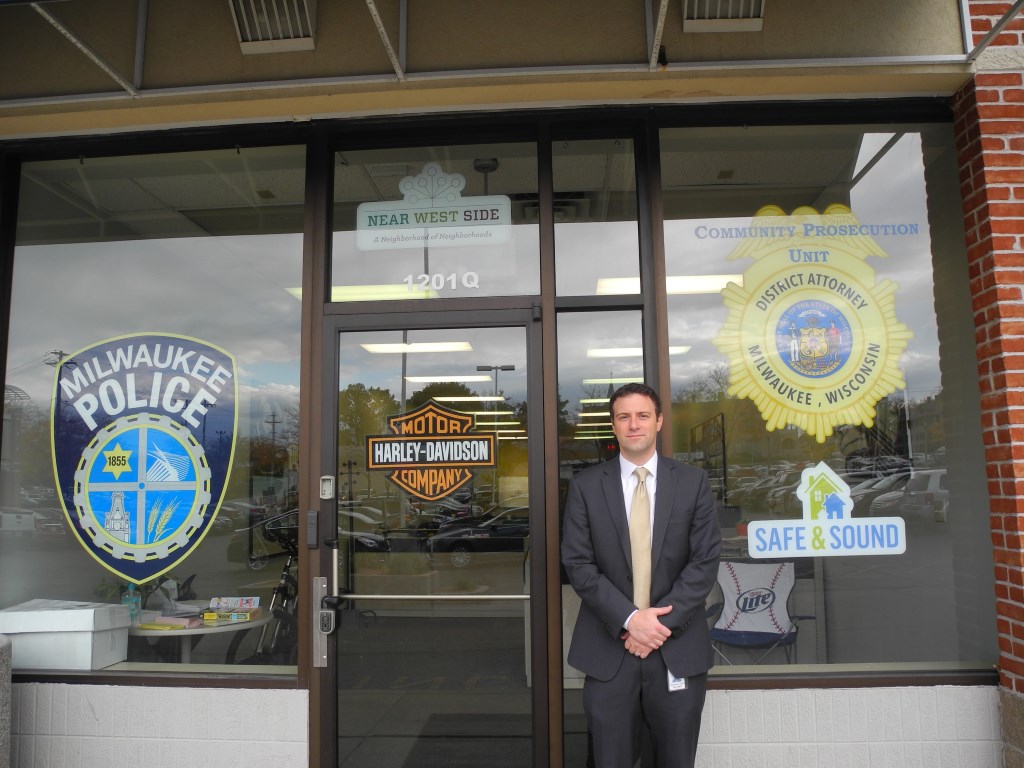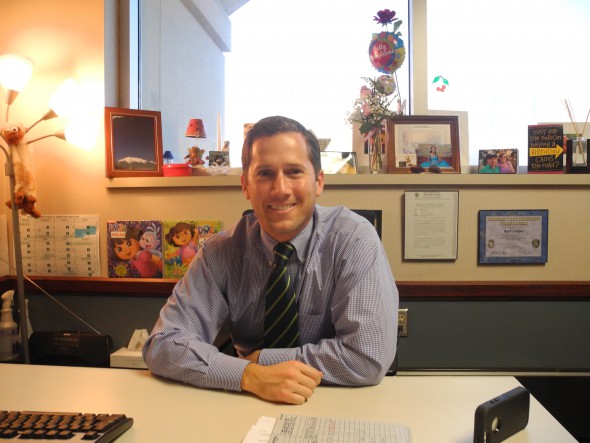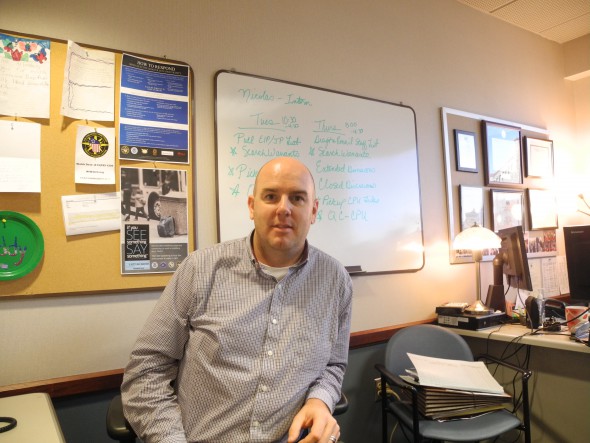How Community Prosecutors Prevent Crime
Special unit focuses on collaborating with community and crime prevention.
At his storefront office on 35th St. just north of McKinley Blvd, Assistant District Attorney Christopher Ladwig was concerned about some crimes in his district. He was preparing for back-to-back meetings with two neighborhood gas station owners. Calls for police service had been received from both stations, after incidents of loitering and armed robbery. Ladwig’s team wanted to make sure the landlords – owners of the gas stations — were in the loop.
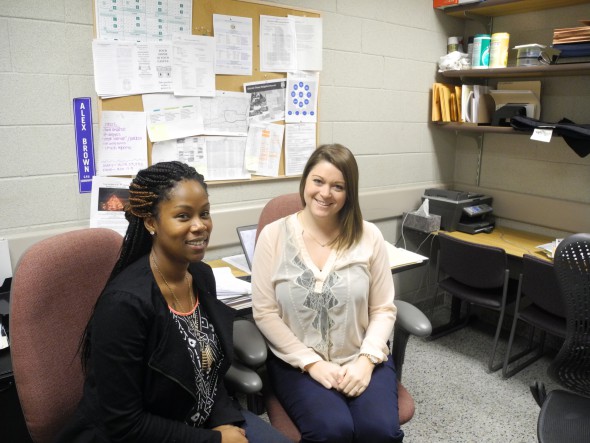
Meghan Johnson and Alex Brown – District 3 Community Prosecution Unit Coordinators from Safe & Sound. Photo by Laura Thompson.
Ladwig had assembled a multifaceted team: several police officers, a team coordinator from the nonprofit Safe & Sound, and representatives from Milwaukee’s Department of Neighborhood Services. Meghan Johnson, of Safe & Sound, brought background information about each property and landlord, and the DNS workers came prepared with records of building inspections and permits. “Do you have any idea what’s attracting this kind of attention to your property?” Ladwig asked the gas station owners. “Are you selling wrappers? Glass pipes?”
One of the landlords was shocked to learn of recent armed robberies at his gas station, and asked for tips to deal with loiterers. The police officers recommended restraining orders, and gave out cell numbers for the beat cops patrolling the area. After quizzing the landlords about security measures already in place, Ladwig suggested hiring a security guard for the times when calls to the police were highest. Finally, Ladwig said his team planned to do a crime prevention survey of each property and would share the results with the landlords. Ladwig’s team hoped their strategies would help the landlords prevent minor incidents from escalating.
Ladwig’s team does this collaborative work as part of the District Attorney’s Community Prosecution Unit (CPU). Community prosecution is a far cry from the work most prosecutors do: standard “case processing,” examining cases brought to them and deciding which ones to charge in court. By contrast, community prosecutors are embedded at a district police station (or in this case, within a strip mall), where they proactively address issues important to the surrounding neighborhood.
“It offers a prosecutor the ability to actually see that you’re making a difference,” Milwaukee County District Attorney John Chisholm says. “They can actually see the impact of the work they’re doing. On the flip side, they can see the challenges too, which is just as important.”
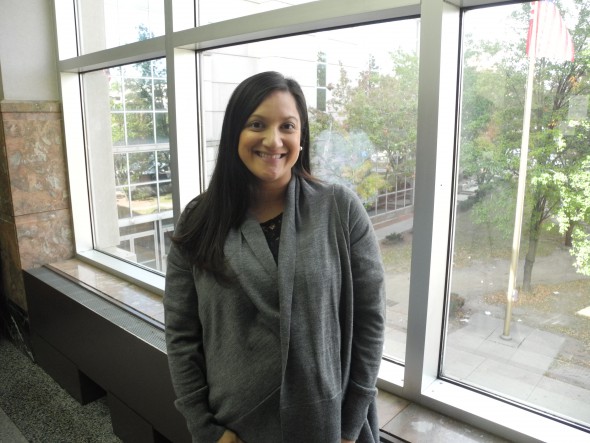
District 2 Community Prosecutor Ann Lopez at the Milwaukee County Courthouse. Photo by Laura Thompson.
South side CPU prosecutor Ann Lopez focuses much of her work on prostitution cases, whereas District 4 (on the northwest side) community prosecutor Dax Odom takes on many domestic violence cases. Attorney Ben Wesson often works cases involving violent juvenile offenders in District 7 (on the north side). The cases the CPU takes on are often compounded by drug addiction, poverty, and homelessness.
A key element of their approach is building alliances with local residents, community groups, and institutions. Each prosecutor works very closely with a coordinator from Safe & Sound, who acts as a bridge between the prosecution team and the community. District 3 CPU Coordinator Alex Brown says, “We are the voice of residents in the community, because a lot of times, they might not feel comfortable going to the police with concerns.” The CPU coordinators meet residents by organizing and attending neighborhood events, including a monthly crime and safety meeting in each district.
In addition to coordinators from Safe & Sound, each district CPU includes several police officers assigned full-time to the team, as well as probation and parole agents from the state Department of Corrections. They also work with housing inspectors from the city Department of Neighborhood Services, and representatives of the city Department of Public Works. “We’re trying to be proactive and preventative,” Lopez notes. “We’re trying to bring in ideas from community-based organizations, churches, anybody who has a stake in the community.”
Ladwig describes community prosecution work as focusing on person-based, place-based, and collective efficacy interventions. What is collective efficacy? “A fancy term for communities working together, working with entities in the city,” Ladwig explains. “Ideally, you’re working together, and you have informal social controls in your neighborhood, so you don’t need the police as much.”
Traditionally, Milwaukee’s city attorneys tackle place-based crime, while District Attorneys handle person-based crime. “Person-based is what you would think of as traditional enforcement. Police get a report of criminal or nuisance activity, go to the location, investigate, arrest someone or bring charges to me,” Ladwig says. He then evaluates the case to decide on either traditional prosecution “or if it is someone we can funnel into a treatment program.”
But the CPU teams have also found place-based interventions essential to their work. Ladwig’s team does a “360-degree analysis,” where they examine each property in a particular area, noting the physical condition, permits filed, owners, and tenants at each location. Additionally, CPU police officers do “crime prevention through environmental design,” noting potential changes that could make an area safer. The teams monitor shots fired and calls for service within their district, and when crime occurs in the district, they meet with landlords. Near west side CPU Coordinator Johnson says, “We intervene on every robbery, every homicide, and on shots fired. We’ll send a letter to the landlord, because a lot of times, landlords don’t know.”
Community prosecution is part of a nation-wide trend to try to bridge the gap between residents and law enforcement. According to Bruce Green and Alafair Burke, community prosecution arose as an outgrowth of community policing, which has gained ground since the 1970s. In their article “The Community Prosecutor: Questions of Professional Discretion,” they write, “In contrast to traditional policing, community policing looks to the community, not just as witnesses and victims, but as stakeholders who help shape law enforcement’s priorities and design and implement solutions.” Community prosecution works from the same stakeholder approach. As Brown notes, “It’s really important to empower residents to organize themselves. It’s good to be a resource for them, but you don’t want to take everything over for them, because you want them to sustain what they’re doing in their neighborhoods.”
Milwaukee’s Community Prosecution Unit began in 2000, when then-Assistant DA (now municipal court judge) Derek Mosley pitched the idea to then-District Attorney E. Michael McCann. They applied for a grant from the U.S. Department of Justice, and received funding to start a CPU team in the Harambee neighborhood of District 5. CPU team captain and District 5 community prosecutor Jacob Corr recounts, “When we started, there were two prosecutors assigned to one district, and we were dealing with nuisance activity. It was ill-defined what we were doing, so we made it up as we went,” adding police officers and prosecutors to the team. Ald. Bob Donovan “liked what we were doing,” Corrs continues, so he found funding for a south side prosecutor. “We started working with building inspectors because we saw how important the physical places were. Art Dahlberg (then Commissioner of the Department of Neighborhood Services) redesigned his entire office around this program. So now all of the building inspectors are geographically-based and work with our teams in order to make sure they are addressing the same problems that we see.”
When Chisholm began campaigning for district attorney in 2006, he made the Community Prosecution Unit central to his platform. “We decided we’d really like a (CPU) prosecutor in each of the district stations, and by 2007, we finally achieved that,” he notes. “You get somebody in each of those areas, pair them up with neighborhood-based organizations, identify what the problem is, and come up with community-based solutions. Sometimes it requires a full-blown law enforcement effort, but many times, it’s prevention-oriented strategies.” The goal, he notes, is to prevent crimes and “develop neighborhood cohesion.’”
Each community prosecution team tailors their work to the district’s unique challenges. On the south side, Lopez works in both districts 2 and 6. She is bilingual, and often tackles issues facing the immigrant community. She has prosecuted “gypsy scammers,” who advertise on Spanish-speaking radio stations, and con people out of thousands of dollars. She prosecuted a police impersonator, who pressured residents to pay fictional fines. But her largest focus has been prostitution, which is commonplace along S. National Ave., S. Greenfield Ave., and S. Lincoln Ave. She reviews any prostitution arrest in her district, “because a lot of these women have addiction issues.”
For women who don’t have violent criminal records, Lopez offers two alternatives to traditional prosecution. One – the most favorable – is a diversion. “Instead of charging them, we offer them six months to participate in a program such as the Sisters Program at the Benedict Center.” If they participate, don’t pick up any other tickets or criminal cases, and stay clean for six months, then no charge is ever issued. The other alternative is called a Deferred Prosecution Agreement, in which the case is held open while the defendant participates in addiction treatment for six to nine months. If the defendant successfully completes the program, the case is dismissed or amended to a ticket.
On the northwest side, Wesson describes his CPU district as a community under siege. He targets prolific criminal offenders by prosecuting armed robberies, shootings, and burglaries. But he also sees himself as a liaison between the DA’s Office and the community. “The biggest thing is trying to develop stakeholders that can step up and help in the problem-solving process, and take control of some of these issues at the neighborhood level.” He is currently working on a project involving the 30th Street Industrial Corridor, to unite its businesses around the goal of public safety. “Getting everybody on the same page to try to achieve that goal is always difficult when you have a bunch of different partners who are not tied together by a contract. This requires everybody to see eye-to-eye, and it’s an ongoing process.”
CPU prosecutors also work together on crimes that cross multiple district boundaries. Chisholm recalls a project in Districts 2 and 3 to reduce juvenile auto thefts: “These crews were operating between north and south. They’d steal cars on one side and drive on down to the other side.” Wesson often works closely with the prosecutors in Districts 3 (Ladwig and Chad Wozniak) and 5 (Corr). “Our problems tend to gravitate towards the middle of those three districts, where they overlap,” Wesson notes. “People who are dealing drugs, who are involved in guns, committing armed robberies — they don’t follow district borders.”
The CPU also provides on-the-ground information for larger investigations taking place with the DA’s Office. Says Chisholm: “There’s no major case they don’t play some role in; if we’re doing a wire tap or a long-term conspiracy case, the community prosecutors are providing updated intel all the time.”
Because of funding challenges, there is no longer a community prosecutor in District 1, which includes the East Side and Downtown. Wesson was briefly the community prosecutor in District 1, where “I was focused on interaction with the business community, local politicians, and UWM,” he says.
“There’s a huge need for a community prosecutor in District 1,” Chisholm contends. A District 1 prosecutor would need to focus on homelessness and populations with mental illness, whom he says are concentrated between Downtown and W. 27th Street.
There also used to be a community prosecutor stationed in several Milwaukee Public Schools, but that position was also scrapped due to lack of funding.
But things are looking up in District 3, where five powerful “anchor institutions” — Harley Davidson, MillerCoors, Aurora Health, Marquette University, and Potawatomi Casino — have banded together to fund the Near West Side Community Prosecution Unit. Under the terms of a three-year safety and neighborhood improvement grant, this CPU team focuses mainly on the neighborhoods surrounding the funding institutions. Another team handles the rest of District 3, and is based at the police station. The two teams work closely together.
What has been the overall impact of the CPU’s work? “I think all of us have stories about positive change,” Corr says. “You shut down a drug house, and the next day kids are out playing.”
“Now when I go to neighborhood meetings,” Chisholm says, “they might be mad about something I’ve done, or a decision that I’ve made, but they’ll always say that ‘my community prosecutor told me this,’ so they identify that person as theirs. If they’re developing a relationship that is so close that they’re looking at this person as somebody that gets problems solved, and not as a traditional prosecutor… that’s when you know the concept is working.”


